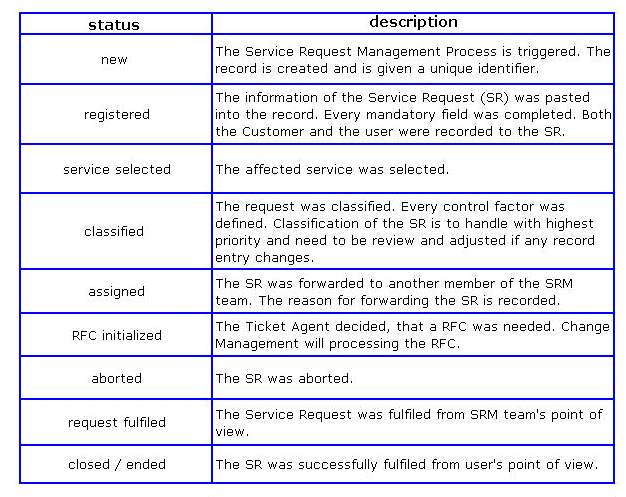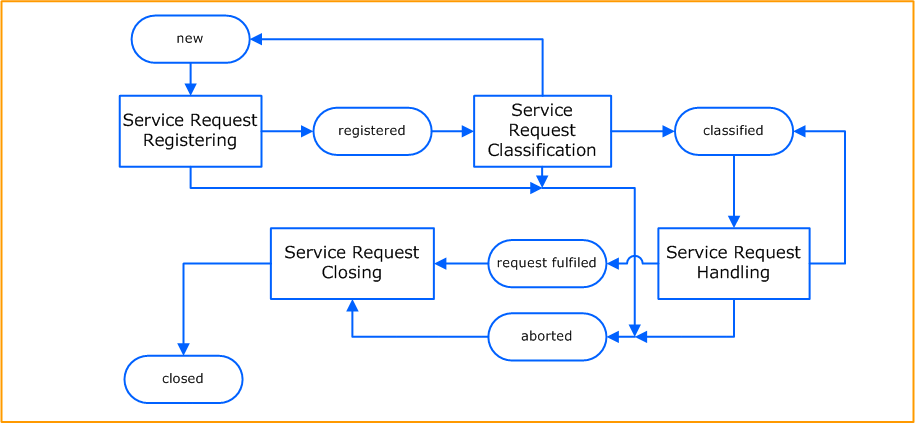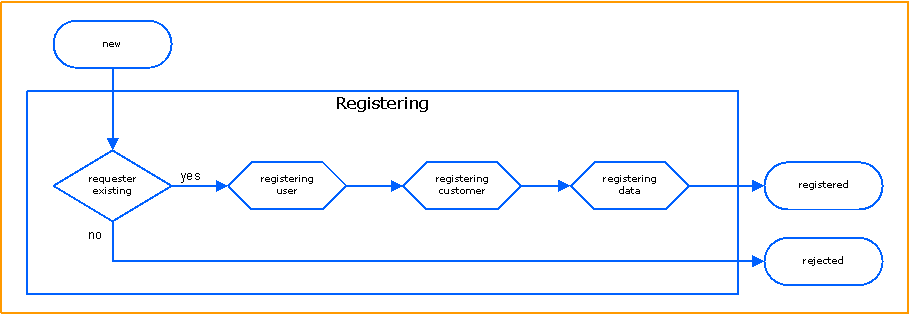Service Request Management
Description/Summary
In the Service Request Management all Requests according to a service will be processed. The Service Request Management is monitoring and reporting the agreed Key Performance Indicators (KPI) corresponding to the compliance with customer and management.
The duty of providing information to the user is part of the Service Request Management controls. The most important actor in in the Service Request Management is the function Service Desk. The Service Desk is basically responsible for the Acceptance, Classification and also handling of request. The process Request Fulfillment in ITIL V3 deals with Service Requests and is the corrsponding counterpart to the Service Request Management.
Objectives
The purpose of Service Request Management is to accept and register Service Requests and directly handling them according to the urgency.
The superordinate objective of the Service Request Management is the contentedness of the user.
Roles & Functions
Service Request Management specific roles
Static Process Roles
- Service Request Management Process Owner
- Initiator of the process, accountable for defining the process strategic goals and allocating all required process resources. See Continual Process Improvement Management for a detailed description of these activities.
- Service Request Management Process Manager (Service Request Manager)
- Manager of the entire process, responsible for its effectiveness and efficiency. Team leader of the function „Service Request Management Team“.
- Service Request Management Team
- Team associated to the Service Request Management Process.
- Senior Management
- Senior Management of the IT provider
Dynamic Process Roles
These roles are dynamically created during the Service Request Management Process. See the process-specific or activity-specific rules for details.
- Service Request Owner
- The attribute in the records contains the value of the Role/Function currently accountable for the Service Request (but NOT for the Service Request Management Process). The Service Request Owner can be changed with the help of a Hierarchical Escalation.
- Service Request Agent
- The attribute in the records contains the value of the Role/Function currently responsible for either an activity or task within the overall activity of the request. The Service Request Agent can be changed with the help of a Functional Escalation, if permitted by the Rules.
- Service Request Requester (SRR)
- This is the person who triggers a request via a Service Request (SR) form. This can be identical with a service or customer specific role.
Service Specific Roles
Roles depending on the affected service are found in the Service Description. The Service Description, including the service specific roles, is delivered from the Service Portfolio Management.
Example: Service Description
Service Expert/Service Specialist
They can consult at
- Classifying Service Requests
- Request fulfilment
- Service Owner
Customer Specific Roles
Roles depending on the affected customer(s) are found in the Service Level Agreement (SLA). The Service Level Agreement for the customer specific roles is maintained by the Service Level Agreement Management.
- Customer(s)
- Customers of the affected Service with a valid SLA
Information artifacts
This section describes information/data required or recorded by the process. In general, a Process Record (here: the Service Request Record) represents the current progress of a process and will contain all information related to the execution of that process. Additional information items (artifacts), such as the Request for Change (RFC) in the context of Change Management, typically can be realized by considering the information out of one or more (up to all) process records and either filtering, merging, correlating or interpreting these information, sometimes with regard to the context of other data and information sources.
Service Request Record
Definition
The Service Request Record is the record holding any management-relevant information and history of a specific request. On creation, it is based on (filled with) the information provided by users request, selected customer and service.
- Unique identifier
- Service Request ID (ticket id)
- Ticket Owner
- Person registering and accepting the request
- Ticket Agent
- Assigned person currently working on that request
- Service Request proposer
- Name of the Person triggering the Service Request
- Status
- Status of the request. Is set when passing a Control Activity
- Services
- Service(s) affected by this request
- Customer
- Customer(s) affected by this request
- User
- User(s) affected by this request
- Description
- The description of the change including the Change Argument
- Resolution Time
- The resolution time depends on the priority of the request
- Times Request forwarded
- Forward-history is saved to the record
- Request Working Minutes
- Time spend actually working on that request
- Triggered RFC UID
- The UID of the RFC initialized by the Service Request
- Solution Describtion
- The describtion of handling the request
- Closing Code
- Basically standard codes, that are necessary for the reporting and patterns of events
- Closing Comment
- Additional Information to the closing activity
- Additional Remarks
- Text for additional information
Service Request Record attributes x activity matrix
For icon descriptions see Record attributes X activities
Key Concepts
Service Request Classification
The Service Request needs to be classified and a resolution date is to be defined. Classification ia a continual process, till the request is fulfiled. The resolution date is to set to a date which assures that the SLA is not infringed.
Service Request Controls
Process
High Level Process Flow Chart
This chart illustrates the Service Request Management process and its activities
Critical Success Factors
Critical Success Factors (CSF):
- Obey the process in every case
- Continouus review of Serivce Request’s classification respectively the resolution date
- Cooperation with the Change Management
- No personal union between Service Request- and Change Manager
- High ratio of contentedness of the user.
- High ratio of fulfiled Service Requests
- High ratio of Service Requests with short Reaction- and fulfilment-time
Performance Indicators (KPI)
- Details from audit
- on time?
- in budget?
- Ratio open/total number of requests
- Ratio fulfiled/aborted requests
- Causes of the request
- Average time of answer, reaction and fulfilment
per service, per user, per customer, per location, per category, …
Process Trigger
Event Trigger
- Any Service Request by an user
For more information see the relevant Process Interface Description in the Process Interfaces Overview
Time Trigger
- None (Service Request Management is typically event-triggered)
Process Specific Rules
- every Service Request triggers the creation of a new Service Request Record.
- the Ticket Agent is responsible for documenting each activity in the Service Request Record
- the Service Request Owner has to control the Ticket Agent
- the Service Request Owner and Ticket Agent can only transfer their duties if the new person or group agrees
- the subsequent Service Request Owner or Service Request Agent must then be recorded in the appropriate attribute in the Service Request Record.
- the Service Request Owner and Ticket Agent should preferably be a person rather than a group.
- refer to the Service Description and Service Level Agreement in order to take service specific and customer specific rules into account
Note: for the different types of rules see Rules.
Process Activities
Service Request Registering
Activity Specific Rules
- Service Request proposer is set to the person who triggered the Service Request
- Ticket Agent is set „Service Request Management Team“ if there is not a person as ticket agent available
- Ticket Owner is set „Service Request Management Team“ if there is not a person as ticket agent available
- Service Request Owner is set „Service Request Management Team“ if there is not a person as request owner available
- Service Request Description The ticket must contain a meaningful description of the desired request as well as a comprehensible rationale stating the reasons for the request.
- Customer is set to „default customer“ if no other customer is known.
- User is set to „default user“ if no other user is known.
- Request Working Minutes are to increase by the minutes the agent was working on the ticket
Service Request Service Selection

Activity Specific Rules
- Service is set to a service out of the Service Portfolio
- Request Working Minutes are to increase by the minutes the agent was working on the ticket
- Status is set to „service selected“, if the affected service was identified successfully
Service Request Classification

Activity Specific Rules
- Resolution Date is set to the neccessary value (date), so that the SLA is not infringed by delayed fulfilment
- Request Working Minutes are to increase by the minutes the agent was working on the ticket
Service Request Handling
In this activity, …
Activity Specific Rules
- Ticket Agent is set to current responsible person
- Times Request Forwarded is set to the times the ticket was assigned to different ticket agents
- Triggered RFC UID is set to the UID of the generated Request for Change – please refer to Change Management
- Solution Describtion is to be filled up.
- Request Working Minutes are to increase by the minutes the agent was working on the ticket
Service Request Closing
In this activity, the success of an filfiled Service Request is evaluated and the solution is described.
Activity Specific Rules
- Closing Comment is to ne set by the Ticket Agent
- Closing Code is to ne set by the Ticket Agent
- Status of the Service Request instance is closed
- at the end of the activity the Ticket Agent is set to Ticket Owner




